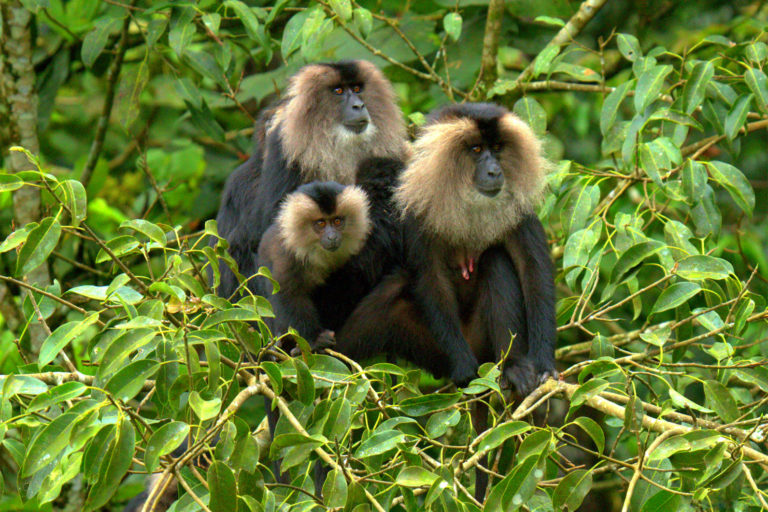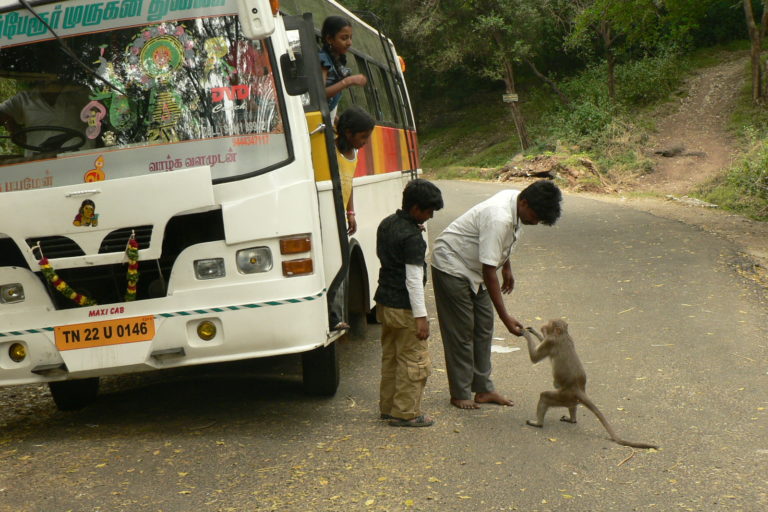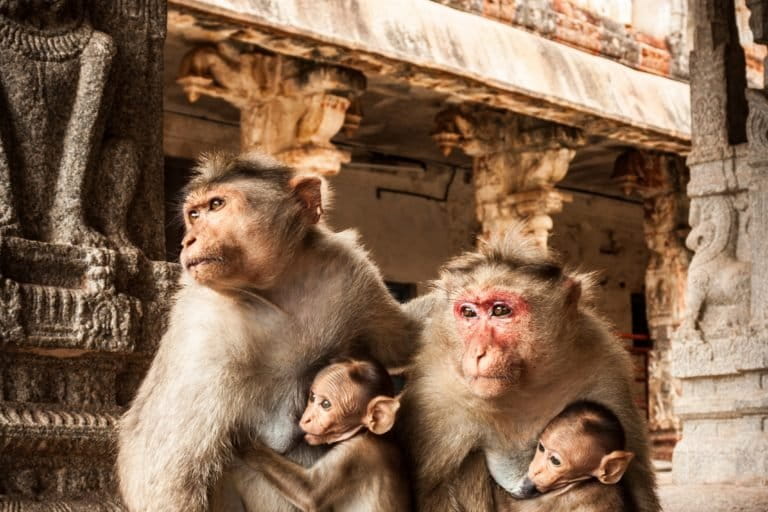- A primatologist reviews 40 years of research on two species of monkeys in South India and offers some lessons for conservation.
- A recent paper highlights the issues faced by the Lion-tailed macaque, a forest-dwelling monkey species, and the Bonnet macaque, a monkey that prefers living around humans.
- For Lion-tailed macaques, strategies suggested are the largescale restoration of its rainforest habitat, extending sanctuaries where possible and protecting important rainforest corridors in the Western Ghats.
- For the Bonnet macaques, the paper advocates identifying and protecting forest patches close to human habitation, such as temples and tourist spots on hillocks and planting more food trees in these habitats.
In the popular Aesop fable about a country mouse and its city mouse, the country mouse arrives at the city wanting to see for itself all the abundance and variety of food that living in proximity with humans afforded its city cousin. When their meal is interrupted by a pack of dogs, the country mouse packs its bags and tells its cousin: “Goodbye. You do, indeed, live in a plentiful city, but I am going home where I can enjoy my dinner in peace.”
Lion-tailed macaques (LTM) and Bonnet macaques, monkey species from southern India, may relate to this tale. Although closely related, these two monkey species have vastly different behaviours and needs. LTMs are arboreal monkeys, endemic to the wet evergreen rainforests of the Western Ghats. With rainforests disappearing, LTMs have been increasingly losing habitat. The species is today considered threatened by the IUCN (International Union for Conservation of Nature). Less than 1000 individuals survive in the wild.
In contrast, the Bonnet macaque is also endemic but to the entire south Indian region below the Tapti and Godavari river. Although primarily fruit eaters like the LTMs, these monkeys can survive in a range of habitats and seem to thrive around human habitation, especially close to temples, fields and roadsides. Ecologists estimate that around 30000 individuals survive in the wild and the IUCN considers them to be of least concern.
There is much conservationists can learn from their different life histories according to Mewa Singh, a primatologist and behavioural ecologist and distinguished professor at the Mysore University. In a new paper, Singh, who has been studying the two species for over 40 years, reviewed what is known of their ecological needs, examines different conservation measures and makes suggestions for two very different management strategies.
“In general, you can classify species as some are obligatory forest dwelling. And some are largely commensal, i.e. they live close to people and share their habitats and resources,” explained Singh. Just as the town mouse cannot live in the countryside and the country mouse in the town, LTMs and Bonnets need different habitats to survive. “So, when we have to think of wildlife conservation, we need different strategies for these two kinds of species.”

Singh illustrates this point in his review, by comparing the state of LTMs in the Annamalai rainforests and Bonnet macaques in the outskirts of Mysore city.
The Forest Macaque
Lion-tailed macaques are an arboreal species. In an undisturbed rainforest, they move through the canopy of connected trees, rarely descending to the ground. This canopy highway is essential to the species because of their food preferences. LTMs primarily eat fruits (about 80 percent of their diet) and fruits grow throughout the year only in evergreen forests. These fruiting trees are spread far apart. So, LTMS spend most of their day traveling across the canopy searching for fruits.
Because a large continuous stretch of rainforest is crucial for these species, Singh suggests that forest departments create sanctuaries in rainforest stretches which are not currently protected. “For example, the Karnataka forest department has done it,” he said. The Sharavathi river valley in the Karnataka Western Ghats is home to approximately nine troops of four hundred LTMs.
In 2017, the Karnataka forest department created the Agnashini LTM reserve in the Sharavathi Valley. The reserve has an area of 299 square kilometres, where local communities retained some rights to the forest, but the area was recognised as an important LTM habitat. In 2019, the forest department extended formal protection to the Agnashini reserve and added it to the existing Sharavathi Wildlife Sanctuary and renamed it the Sharavathi Lion-tailed Macaque Sanctuary, recognising the primate as a flagship species of the region.

Singh praised this move and said it was vital considering LTMs in this region were threatened by hunting but pointed out that this strategy would not work in all places. “It has to be purely forest areas which are, you know, away from people and relatively undisturbed,” he said. But in large parts of the LTM’s range in the Western Ghats, undisturbed forests are hard to come by.
The Annamalai Hills in the Central Western Ghats in Tamil Nadu, is home to some of the largest populations of LTMs. But these rainforests have been broken up into smaller fragments by tea plantations, human habitation, roads and electric lines. “Animals like lion-tailed monkeys will usually not leave the forest. They cannot move in between the tea gardens,” said Singh. The canopy highway, which the LTM needs to travel, is cut off.
“So, they are now simply confined to a small fragment. Another group is confined to some other forest fragment. There is no mixing of the population at all,” he added.

To connect these isolated populations, Singh highlights two crucial conservation measures that have worked in this region. The Nature Conservation Foundation (NCF), an NGO built rope bridges connecting canopies of rainforests cut off by roads. This has helped minimise the need for the macaques to descend on the ground to get to a forest on the other side.
NCF has also been restoring rainforests in patches of abandoned tea plantations for the past 15 years. Though no substitute for an ancient natural rainforest, a recent study showed that these restored patches helped in the natural regeneration of 92 species of rainforest trees. Canopy cover in restored sites recovered by up to 82 percent, compared to undisturbed forest.
“That is a fantastic project to show how these degraded habitats can also be enriched, and how the same tree species can be used to establish corridors also,” Singh said.
However, Singh pointed out that NGOs were limited in resources and reach. Instead, he advocated that the Tamil Nadu Forest Department should buy up private land that lies in between these forest fragments and restore rainforests. The process would be long and arduous, he acknowledged, but not impossible. “Even if they have to get 200 hectares of land, I don’t know how many papers you have to move, how many years it will take, who will buy the land, who will be the owner of the land. The government machinery is a bit slow. But if they move, they move.”
The Town dweller
While the challenge with LTMs is finding good solutions for their conservation, with Bonnet macaques, the first step is convincing management authorities that the species needs attention. Bonnet macaques differ from LTMs in one crucial way. They are by nature commensal — they live close to humans and benefit from human habitation. Singh and his colleagues noted in multiple studies that within forests, bonnet macaques tend to be in smaller numbers. “And even those which are there in the forest, they’re also always near the forest edges close to the road.”
Part of the reason for this appears to be that unlike LTMs, Bonnet macaques are not specialised in their diet. Apart from fruits, leaves and insects, bonnets can also eat human food. This has led to them congregating in large numbers near temples and tourist sites that are close to small forest patches, where people feed them. They are also found on tree-lined roads and plantations near villages.

This, coupled with the fact that these species are found across South India and in much larger numbers, has led people to believe they are not threatened. Indeed, even the IUCN has declared them Least Concern.
“We are part of the Primate Specialist Group, that has declared them as Least Concern,” admits Singh ruefully. “But the reasons considered for this categorisation are not accurate. We are working on changing this now, because they are definitely declining.”
What could be threatening such a ubiquitous species?
In a 2017 study, Singh and his colleagues who have been monitoring bonnets in some parts of South India, have shown that bonnet macaque populations have been declining around temples and tourist places in Tamil Nadu, Karnataka and Kerala. One reason for this appears to be reduced tolerance. The study noted that bonnet macaques were often extremely bold and grab food from people or vehicles near temples. This conflict has led to them being relocated and even killed.
Increasing urbanisation, especially around roadsides, also led to monkey declines. Over the past 40 years, Singh and his colleagues have also monitored bonnet macaque populations around major highways leading in and out of Mysore city. While monkey populations were relatively stable in the nineties, they documented a noticeable decline between 2001 and 2015. During this period, these highways have seen major tree felling, increased urbanisation with buildings and construction and a decline in water bodies like tanks.
But in human-dominated areas with adequate forest cover, bonnet macaque populations appeared to be much more stable. For instance, Singh and his team have been monitoring the species for over 30 years in the Chamundi hills in Mysore. Chamundi hills are covered with a dry scrub forest with a temple at the top. The area is a popular tourist destination in the city but with a stable monkey population ranging from 210-220 individuals.

“The most remarkable stability for 30 years; I have never seen this in any population of any animal species,” said Singh. He noted that this was because the forests around the Chamundi temple had a lot of fruit trees that could sustain the monkey population. This case offers an important lesson, according to Singh. We cannot wish away humans or force bonnet macaques to remain in isolation. We cannot depend on human beings to sustain and feed them either.
“So, what we have to do is find out places with good forest, close to people, because that’s what their nature is.”
“And there are thousands of such places in India, you know. Wherever you go see some hillock, right on the top, there’ll be some temple with a lot of forest around there. So, if those habitats can be preserved, plant some more fruit trees, for example, and such are the places where the monkeys can be preserved,” Singh concluded.
CITATION
Singh, M. (2019). Management of Forest-Dwelling and Urban Species: Case Studies of the Lion-Tailed Macaque (Macaca silenus) and the Bonnet Macaque (M. radiata). International Journal of Primatology, 40(6), 613-629.
Osuri, A. M., Kasinathan, S., Siddhartha, M. K., Mudappa, D., & Raman, T. S. (2019). Effects of restoration on tree communities and carbon storage in rainforest fragments of the Western Ghats, India. Ecosphere, 10(9), e02860.
Erinjery, J. J., Kumar, S., Kumara, H. N., Mohan, K., Dhananjaya, T., Sundararaj, P., … & Singh, M. (2017). Losing its ground: A case study of fast declining populations of a ‘least-concern’ species, the bonnet macaque (Macaca radiata). PloS one, 12(8).